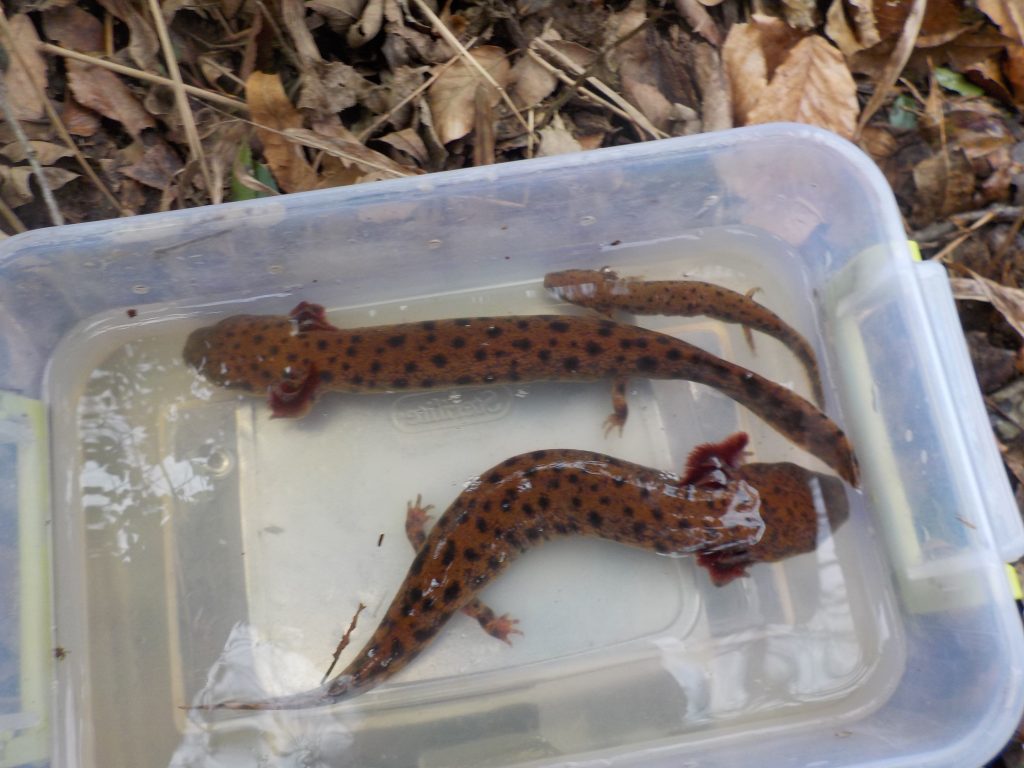By Eric Teitsworth, a master’s student in the Fisheries, Wildlife, and Conservation Biology program at NC State University
 Beneath the murky rivers of eastern North Carolina, lurks an ancient creature that few know and even fewer have seen. Rivers and streams in the Neuse and Tar watersheds are the only place on earth that you can find the Neuse River Waterdog. A gentle giant among salamanders, the Neuse River Waterdog is a brown and black-spotted water-dwelling creature that can reach lengths of a ten inches or more. These salamanders are rarely encountered due to their aquatic lifestyle and excellent camouflage and most people are totally unaware of their existence. Unfortunately, this also means that scientists and wildlife biologists have a difficult time determining how healthy their populations are.
Beneath the murky rivers of eastern North Carolina, lurks an ancient creature that few know and even fewer have seen. Rivers and streams in the Neuse and Tar watersheds are the only place on earth that you can find the Neuse River Waterdog. A gentle giant among salamanders, the Neuse River Waterdog is a brown and black-spotted water-dwelling creature that can reach lengths of a ten inches or more. These salamanders are rarely encountered due to their aquatic lifestyle and excellent camouflage and most people are totally unaware of their existence. Unfortunately, this also means that scientists and wildlife biologists have a difficult time determining how healthy their populations are.
In the early 1980s, the North Carolina Museum of Natural Sciences searched for these salamanders throughout the Neuse and Tar River systems and found them as far North as Eno River State Park and as far south as Greenville, NC. While they still live and thrive in many of these places, Neuse River Waterdogs are becoming more difficult to find. About 30 years later in 2011, the Wildlife Resources Commission went searching again and were unable to find waterdogs in all of the places they once were. Unsurprisingly, most of the populations around the Triangle appear to have declined or been lost entirely. In response, the United States Fish & Wildlife Service proposed the Neuse River Waterdog as “Threatened” under the Endangered Species Act in May 2019. Despite the proposal, the decision will not be finalized until mid-2020. Regardless of the listing decision, we still do not fully know how to protect this species.
 The how of protecting this charismatic salamander is exactly what I am trying to figure out. As a current master’s student at North Carolina State University, I’m seeking to learn where Neuse River Waterdogs can still be found and what their main threats to survival are. By understanding the threats to their population, we can begin dealing with those threats.
The how of protecting this charismatic salamander is exactly what I am trying to figure out. As a current master’s student at North Carolina State University, I’m seeking to learn where Neuse River Waterdogs can still be found and what their main threats to survival are. By understanding the threats to their population, we can begin dealing with those threats.
During my surveys this winter I have visited two locations managed by Triangle Land Conservancy; one location on Middle Creek in Johnston County and another at the Swift Creek Bluffs Nature Preserve in Wake County. Both are just a short drive downstream of Apex and Cary. I searched at the property along Middle Creek and was delighted to find six of these magnificent salamanders, as well as a healthy variety of other aquatic life. I sampled Swift Creek Bluffs with less luck. While I’m sure waterdogs occurred there at one time, that stream has now been fragmented by man-made lakes and impacted by erosion from upstream development. In short, it doesn’t look like Neuse River Waterdogs can still be found there.
However, there is a lesson to be learned here. By the time that the Swift Creek Bluffs Preserve was established, the damage was already done. Cary was exploding with growth and the rules around stormwater management were not as strong as they are today. Had that land and more like it been protected before the rapid growth of Cary, waterdogs may still live there. Downstream in Johnston County, waterdogs can still be found in Swift Creek where the effects of development have yet to wreak havoc on their habitat, but it’s only a matter of time unless we act now.
Luckily, we’re ahead of the curve in Middle Creek. The land surrounding the waters that I found them in is already conserved by TLC. If we continue to support organizations like Triangle Land Conservancy and enable them to protect more land along these waterways, we’re ensuring a future where giant salamanders can still be found in our backyards.
